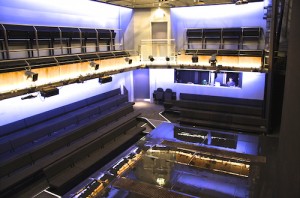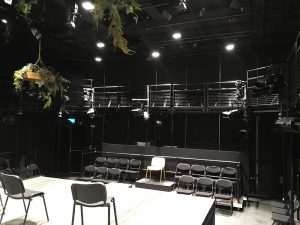February 23, 2021
Although a stage might seem like a straightforward platform, each type has its own unique design, purpose, and technical requirements. Here, we’ll walk through some of the primary stage types, focusing on those that best suit our products
Proscenium Stage
The proscenium stage is what most people envision when they think of a traditional theater stage. Named after the proscenium arch (which, interestingly, isn’t always an actual arch), this structure frames the performance for the audience and provides a “window” into the world of the play. Its origins trace back to the ancient Greeks and Romans, with one of the first recognizable examples found in the Farnese Theatre in Parma, Italy.
In most theaters, these stages are deep, often raked (sloped) from back to front to enhance visibility. They typically feature a fly tower, a high structure where fly bars attach to a grid, allowing drapes, lights, and scenery to be “flown” in and out. To fully conceal set pieces when they’re lifted, fly towers are usually at least twice the height of the proscenium arch.
Another notable feature is the apron—a small section of stage extending in front of the arch. Many theaters also have an orchestra pit in front of the apron, although it’s often covered when not in use, effectively expanding the apron into a thrust.
Proscenium stages can also be created in multi-use spaces like arenas or corporate venues, using trusses, stage flats, or even simple pipe and drape setups for framing. Modular staging elements provide flexibility, helping to build out these stages in less traditional environments.
Common Uses: While most often seen in theaters, proscenium stages are also ideal for corporate presentations, Q&A sessions, award ceremonies, and festivals, lending a sense of structure and formality.
- Advantages: Provides excellent sightlines and a sense of spectacle.
- Disadvantages: Can create a sense of distance, making the audience feel somewhat detached from the performance.

Metrodeck is multi functional in theaters from staging and tiering to stage set,prop tables to work benches
Thrust Stage
Also known as an open stage or platform stage, the thrust stage features an audience on three sides, creating a closer connection between performers and viewers. Although it may seem like a modern design, the thrust stage has deep historical roots, appearing in Spanish corrales, Shakespeare’s Globe Theatre in London, and Japan’s traditional Noh theaters.
The upstage section connects the thrust stage to the backstage area, allowing performers to enter without crossing through the audience. In some cases, there are additional entrances called vomitories, which provide access from the sides.
One key consideration with a thrust stage is that, with audiences viewing from multiple angles, props and set pieces must be placed carefully to avoid blocking anyone’s view. For instance, a prop on stage left could obscure the view for audience members seated on that side.
Thrust stages are easily constructed with modular staging systems and set flats, making them popular in event settings for presentations, Q&A sessions, and fashion shows.
- Advantages: Brings the audience closer to the performance and maintains a backstage area for entrances and exits.
- Disadvantages: Sightlines can be challenging, and set changes may require extra planning to ensure visibility for all.
Theatre in the Round
Also called an arena stage, central stage, or island stage, the Theatre in the Round surrounds the performance area with an audience on all sides. Despite the name, these stages are often square or polygonal rather than round. In many cases, there isn’t a traditional raised stage; instead, the audience area is tiered, rising above the central performance space.
This stage format has ancient roots, with origins in Greek and Roman theater. It was also widely used in Medieval England until the thrust stage took prominence in the Elizabethan era. By the 17th century, it largely disappeared as the proscenium stage gained popularity. However, the arena stage saw a revival in the 1930s, particularly with Nikolay Pavlovich Okhlopkov’s productions in Moscow. In the 1960s, experimental theater companies further embraced this format, valuing the dynamic interaction with audiences and rejecting the perceived constraints of the proscenium setup.
Today, the Theatre in the Round remains popular for its engaging setup. In modern multi-use arenas, this format is often enhanced by features like revolving stages, which allow all audience members to view performances without requiring full mobility from performers—ideal for concerts and other seated events.
- Advantages: Creates a highly engaging atmosphere for the audience and can often accommodate larger crowds within a space.
- Disadvantages: Sightlines can be challenging, requiring careful set and prop planning. Building tiered audience areas can also increase costs.



